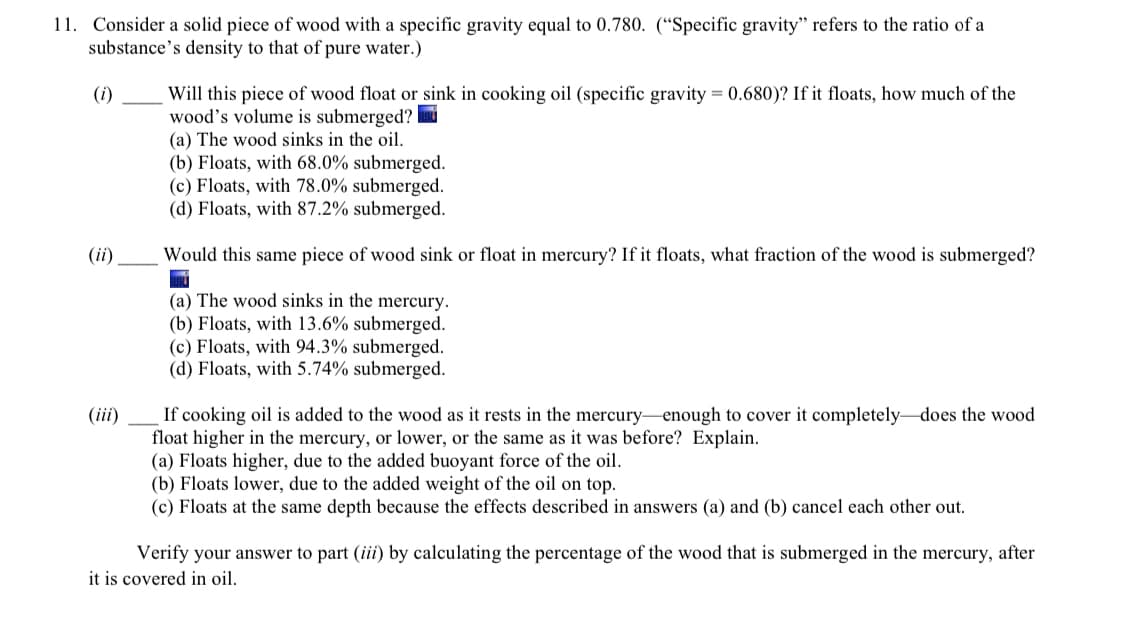Consider a solid piece of wood with a specific gravity equal to 0.780. (“Specific gravity" refers to the ratio of a substance's density to that of pure water.) Will this piece of wood float or sink in cooking oil (specific gravity 0.680)? If it floats, how much of the wood's volume is submerged? lii (a) The wood sinks in the oil. (b) Floats, with 68.0% submerged. (c) Floats, with 78.0% submerged. (d) Floats, with 87.2% submerged. (i) (ii) Would this same piece of wood sink or float in mercury? If it floats, what fraction of the wood is submerged? (a) The wood sinks in the mercury. (b) Floats, with 13.6% submerged. (c) Floats, with 94.3% submerged. (d) Floats, with 5.74% submerged. If cooking oil is added to the wood as it rests in the mercury-enough to cover it completely-does the wood float higher in the mercury, or lower, or the same as it was before? Explain. (a) Floats higher, due to the added buoyant force of the oil. (b) Floats lower, due to the added weight of the oil on top. (c) Floats at the same depth because the effects described in answers (a) and (b) cancel each other out. (iii)
Consider a solid piece of wood with a specific gravity equal to 0.780. (“Specific gravity" refers to the ratio of a substance's density to that of pure water.) Will this piece of wood float or sink in cooking oil (specific gravity 0.680)? If it floats, how much of the wood's volume is submerged? lii (a) The wood sinks in the oil. (b) Floats, with 68.0% submerged. (c) Floats, with 78.0% submerged. (d) Floats, with 87.2% submerged. (i) (ii) Would this same piece of wood sink or float in mercury? If it floats, what fraction of the wood is submerged? (a) The wood sinks in the mercury. (b) Floats, with 13.6% submerged. (c) Floats, with 94.3% submerged. (d) Floats, with 5.74% submerged. If cooking oil is added to the wood as it rests in the mercury-enough to cover it completely-does the wood float higher in the mercury, or lower, or the same as it was before? Explain. (a) Floats higher, due to the added buoyant force of the oil. (b) Floats lower, due to the added weight of the oil on top. (c) Floats at the same depth because the effects described in answers (a) and (b) cancel each other out. (iii)
Physics for Scientists and Engineers, Technology Update (No access codes included)
9th Edition
ISBN:9781305116399
Author:Raymond A. Serway, John W. Jewett
Publisher:Raymond A. Serway, John W. Jewett
Chapter14: Fluid Mechanics
Section: Chapter Questions
Problem 14.7OQ
Related questions
Question
Hello I need help with part (i, iii, and the statement below part iii) with calculations.
The statement: Verify your answer to part (iii) by calculating the percentage of the wood that is submerged in the mercury, after it is covered in oil. Please and thank you.

Transcribed Image Text:11. Consider a solid piece of wood with a specific gravity equal to 0.780. (“Specific gravity" refers to the ratio of a
substance's density to that of pure water.)
Will this piece of wood float or sink in cooking oil (specific gravity = 0.680)? If it floats, how much of the
wood's volume is submerged?
(a) The wood sinks in the oil.
(b) Floats, with 68.0% submerged.
(c) Floats, with 78.0% submerged.
(d) Floats, with 87.2% submerged.
(i)
(ii)
Would this same piece of wood sink or float in mercury? If it floats, what fraction of the wood is submerged?
(a) The wood sinks in the mercury.
(b) Floats, with 13.6% submerged.
(c) Floats, with 94.3% submerged.
(d) Floats, with 5.74% submerged.
If cooking oil is added to the wood as it rests in the mercury-enough to cover it completely-does the wood
float higher in the mercury, or lower, or the same as it was before? Explain.
(a) Floats higher, due to the added buoyant force of the oil.
(b) Floats lower, due to the added weight of the oil on top.
(c) Floats at the same depth because the effects described in answers (a) and (b) cancel each other out.
(iii)
Verify your answer to part (iii) by calculating the percentage of the wood that is submerged in the mercury, after
it is covered in oil.
Expert Solution
This question has been solved!
Explore an expertly crafted, step-by-step solution for a thorough understanding of key concepts.
Step by step
Solved in 3 steps with 1 images

Knowledge Booster
Learn more about
Need a deep-dive on the concept behind this application? Look no further. Learn more about this topic, physics and related others by exploring similar questions and additional content below.Recommended textbooks for you

Physics for Scientists and Engineers, Technology …
Physics
ISBN:
9781305116399
Author:
Raymond A. Serway, John W. Jewett
Publisher:
Cengage Learning

Principles of Physics: A Calculus-Based Text
Physics
ISBN:
9781133104261
Author:
Raymond A. Serway, John W. Jewett
Publisher:
Cengage Learning

Physics for Scientists and Engineers with Modern …
Physics
ISBN:
9781337553292
Author:
Raymond A. Serway, John W. Jewett
Publisher:
Cengage Learning

Physics for Scientists and Engineers, Technology …
Physics
ISBN:
9781305116399
Author:
Raymond A. Serway, John W. Jewett
Publisher:
Cengage Learning

Principles of Physics: A Calculus-Based Text
Physics
ISBN:
9781133104261
Author:
Raymond A. Serway, John W. Jewett
Publisher:
Cengage Learning

Physics for Scientists and Engineers with Modern …
Physics
ISBN:
9781337553292
Author:
Raymond A. Serway, John W. Jewett
Publisher:
Cengage Learning

Physics for Scientists and Engineers
Physics
ISBN:
9781337553278
Author:
Raymond A. Serway, John W. Jewett
Publisher:
Cengage Learning

Physics for Scientists and Engineers: Foundations…
Physics
ISBN:
9781133939146
Author:
Katz, Debora M.
Publisher:
Cengage Learning

College Physics
Physics
ISBN:
9781285737027
Author:
Raymond A. Serway, Chris Vuille
Publisher:
Cengage Learning